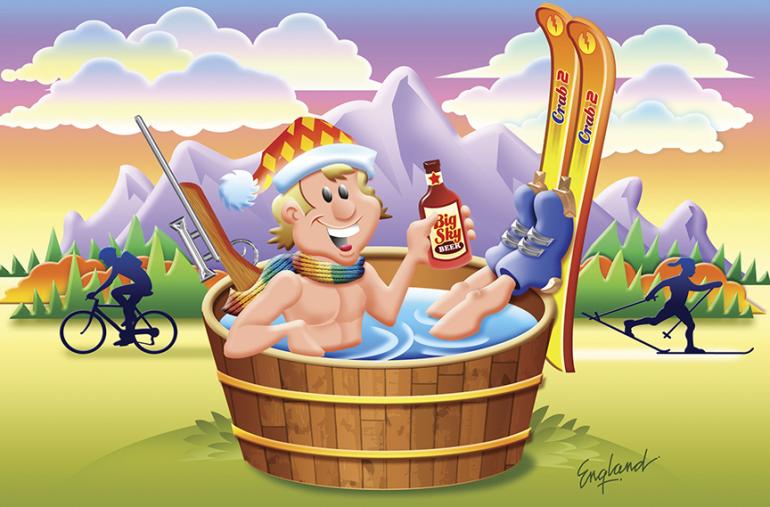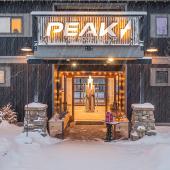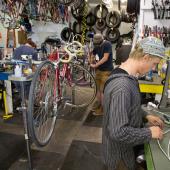Spa Day: Mountain Hot Tub
Tom Walker is taking me into his “mood room.” It’s a dim area containing four or five hot tubs, plants, water that is changing colors, funky music, and a star-scape light fixture that gives the place a planetarium-like feel. Tall, clean-cut, and soft-spoken, Tom is definitely not the hairy-chest-and-gold-chains type some think would have a “mood room,” but that’s because we’re in the showroom of his Mountain Hot Tub dealership.
We are met by Kelly King, the general manager, who is equally pleasant and approachable. Together they guide me around the rest of the showroom, filled with Hot Spring brand hot tubs. The place has the temptation of a mattress store—I want to try them all out. But Tom is eager to hop in the car and show me the warehouse, so off we go. On the way, I ask about Tom’s background and discover that the Bozeman native attended MSU for one quarter and then dropped out. “At that point it didn’t seem like the right thing to do,” he says. Tom raced motocross and worked in construction instead.
He and friend Scott Smith explored hot springs a lot. “That was one of the funnest things we could do back then,” he says. Tom and Scott are part of a long line of hot springs lovers: the practice goes back at least to the ancient Romans, who put hot stones into water for heat. But the restorative powers of spa use made spas part of Japanese, Native American, Egyptian, Turkish, and Nordic cultures centuries ago as well. Today, the therapeutic value of hot tubs is widely known. It relieves gravity’s pressure on the body and stimulates the nerves and circulatory system, which is helpful for sufferers of arthritis, rheumatism, back problems, and muscle cramps. Those are just some of the medical benefits—the mental benefits, especially for those who are allergic to jerks or office politics, are even better.
The hot tub trend of the 1970s was Tom and Scott’s turning point. “The idea of having a hot pot in your own backyard was an out-of-this world concept,” he says, so the two started selling hot tubs in 1979. Tom was just 20, and the risk didn’t bother him. “At that age, you don’t really think about anything; you know, you go skiing and jump off cliffs... There tends to be no fear, you just kind of go for it.”
They didn’t start with much capital. “The number might as well be zero,” he says. “We borrowed money from my partner’s sister to get a hot tub for the first winter fair.” Tom’s parents, personal banker, and even his accountant urged him to go back to construction. “Everyone thought we were crazy,” he says dryly. The display at the fair wasn’t encouraging either: “I don’t think people even realized what they were... One guy asked if it was a sheep dip,” Tom recalls. But eventually people caught on, and by the second year he knew the business had a future.
We arrive at the warehouse, where hot tubs are stacked to the ceiling. In the back is an area for refurbishing used hot tubs. Here I learn that Tom sells more hot tubs per capita than any other Hot Spring dealer. They start at $2,995, but most people spend $7,000 to $15,000. “Who are these people?” I ask, considering that Montana has one of the lowest per capita incomes in the U.S. “It’s the people who like living here,” says Kelly, referring to Bozeman’s active outdoor culture. The customers are of all ages. “Each generation has their reasons for wanting a hot tub,” says Kelly. “Senior citizens want them because of perhaps arthritis, pain relief, or to help them sleep better. Baby boomers want them to get some togetherness, stress release, relaxation, maybe family time. The new generation is... really the first generation that’s raised with hot tubs in the house... it’s just part of their lifestyle.”
Kelly is somewhat of an industry legend, and his 18 years of experience shines as he tells me how to maintain a clean hot tub. Even though it’s easier to tell customers to use chlorine or bromine tablets, Mountain Hot Tubs creates a tailored maintenance “recipe” for each customer based on use, home water samples, and new, less stinky sanitation technologies like ozone. The chlorine stench of the gym’s hot tub is “not the reality of owning a spa at home... it’s a lot more natural,” he says.
We return from the warehouse and sit at a table in the back of the showroom. On the wall is a large picture of Scott Smith, who died in a 2001 car accident and is so revered that Hot Spring named a customer-service award after him.
Also on the wall are pictures of what seems like every hotel hot tub in town. But the hotels aren’t where the business is; the housing boom is. With three stores, the warehouse, a service center in Big Sky, and 18 employees, Tom and Kelly have their hands full. “How many hours a week do you work?” I ask Tom. He sits in silence, thinking, then admits he doesn’t know. “Well, if you couldn’t work in the hot tub business, what would you do for a living?” I continue. Tom again sits in silence, this time longer than the last. Time ticks by. He mumbles something about hobbies, but drops off midsentence, and in the end he honestly can’t think of anything else he’d rather do.
Kelly says he’s had opportunities to get out, but he likes hot tubs too much. Maybe he’d go into teaching, he says reluctantly. “I have five older brothers that all have good jobs and a lot of money, but I have by far the lowest blood pressure of all of them.”
History of Hot Tubs
Tom Walker and Kelly King belong to a long line of people who know there’s nothing like a good hot soak. Hot tubs themselves have been around less than a hundred years, but nature’s hot tubs go back thousands. Dozens of cultures have an affinity for these sites noted in their history books, but the Egyptians are generally thought to be the first to use hot baths and springs for therapeutic purposes.
The Greeks and Romans were especially big fans, and they built many great stone chambers and temples around the hot springs throughout their realms. Some of them still stand today. The town of Bath, England, is perhaps the most popular of these monuments to the Roman reverie for hot springs. Still used by the public, the water in Bath rises from the Sacred Spring at over 100 degrees Fahrenheit every day.
In our own area, one cannot ignore the rich relationship Native Americans had with hot springs far before any European settlers came. Some tribes believe certain hot springs have special healing powers and are neutral zones, used only for peace and healing.
Thousands of years have passed since the first purposeful dip in a hot pot occurred, but the last century has changed people’s relationship with and access to hot bubbly water more than any other time. In 1956, the seven Jacuzzi brothers, émigrés to California from Italy, invented a portable hydrotherapy pump that officially birthed a quickly growing new industry of self-contained hot springs. In the 1960s and 1970s, people began making their own hot tubs out of wine barrels and olive vats in an attempt to imitate the Japanese ofuru, but soon these gave way to the iconic redwood hot tubs that were especially popular in California (and in episodes of Three’s Company). The 1980s and 1990s saw considerable changes in hot tub technology, particularly in portability and filtration. Today, almost every hot tub on the market is self-contained, made of light acrylic or fiberglass, and relatively inexpensive.













